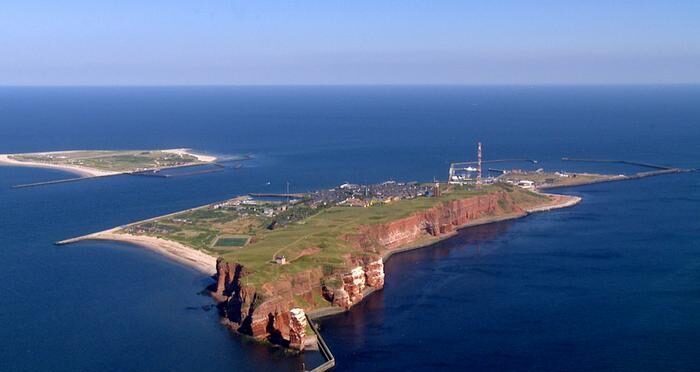The island of Helgoland and Dune
Helgoland (Northern Frisian: Deät Lun (The Country), English: Heligoland, German: Helgoland) is a German island in the North Sea. In the past it was part of Denmark and the United Kingdom, but since 1890 it has been a German landowner.
It is considerably further offshore than the East Frisian Wadden Islands, to which it is not included. The island is known for tourism and the triennial Frisian-drops cultural festival. The municipality of Helgoland is not part of the customs territory of the European Community. As a result, tourism is flourishing through duty-free sales of perfumes, cigarettes, drinks and fuel. Helgoland is known as Helgoland (“Halunder freesk”), a North Frisian language.
Geography
Helgoland is located in the German Bight, relatively far (about 55 km) from the coast in the North Sea and belongs to the German state of Schleswig-Holstein and the Kreis Pinneberg. The island measures 1.7 km² and has a population of 1,265.[1] It has a small beach, but is best known for its red-coloured rocky coastline that rises 47 metres high out of the sea, and for the (now threatened by falls) Lange Anna rocky outcrop. Since the storm of 1720/21 it actually consists of two islands:
The main island with the recognizable cliff of Trias fur sandstone, is divided into Oberland and Unterland with a lift to reach the Oberland. The neighbouring island of Dune is a sand-covered daytime zoom of Jura limestone. It was separated from the main island in 1720 by a strong storm caused by sand erosion. Dune, which is a nature reserve, has an airport and two bungalow parks. The sea lions lie on the beach



To get there, you have to sail or fly. The latter are only small two motorised planes that visit the island. Of course you can also visit the island by ferry from various points. Daytrips people are then taken from the anchored ferryboat to the island in large boats. At the end of the day and tired of shopping, all those people go back the other way around. The sailing boat is an excellent experience. The route to it does require some preparation, outside the Dutch wadden, the German wadden is a notorious stretch of open water in the German bend, where NW and Westenwind can build up a considerable wave of about 2.5 mtr with light wind (4Bft) from the direction of Iceland. There are also two large straits along those coasts with different approaches such as the Alte Weser, Neue Weser and Jade approaching the Elbe into Hamburg. You always have to cross such a strait at right angles, otherwise the print will be waiting for you when you get home. And don’t forget that once these large cargo ships are steamed up, they can easily run at 25 knots (46km/h) and don’t just want to or can’t stop in front of a sailing boat crossing.
Arrival juli, 22nd 2020
My arrival in Helgoland at 16:15. As usual the harbour is already mud-filled, with boat packages of 3 or more boats. I had three reasons to sail to Helgoland this year anyway. Although I have been there many times and have written something about it in my blogs, I thought I would turn it into a more comprehensive blog this time. The island is convenient for me to get there on my trips to Denmark and the Baltic Sea in general. I always make a technical stop there, as we call it in aviation, refuelling and foraging. Since I consume quite a lot of diesel on my journeys, it is worth planning this stopover; the price of diesel is tax-free and, depending on the price of the day, costs between 80 and 90 cents for a reduction of more than 500 litres. Then, of course, there is the cheap malt whiskey. I will stay here for three days now and go back to the Netherlands with a full diesel tank of 1100 ltr, good to get through the winter.







-scaled-390x205.jpg)